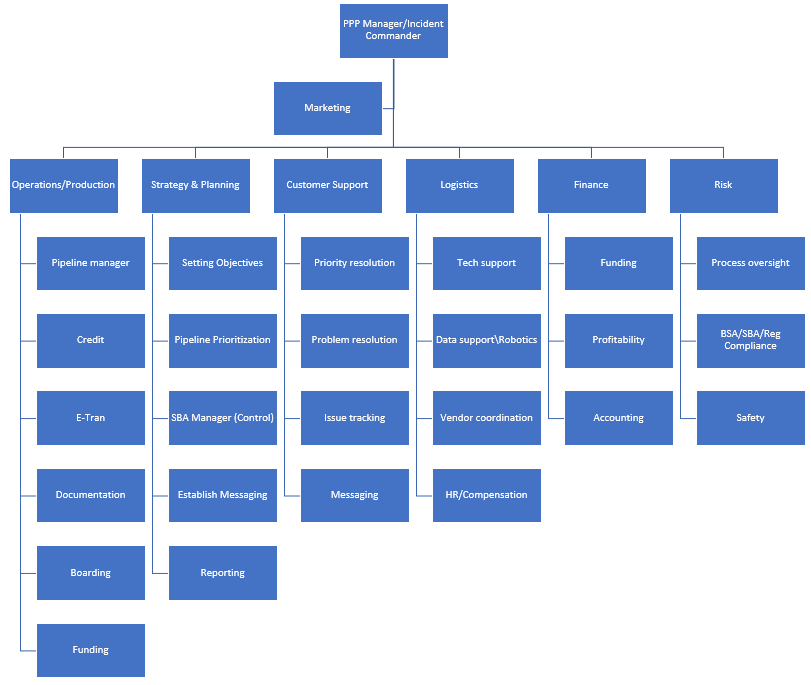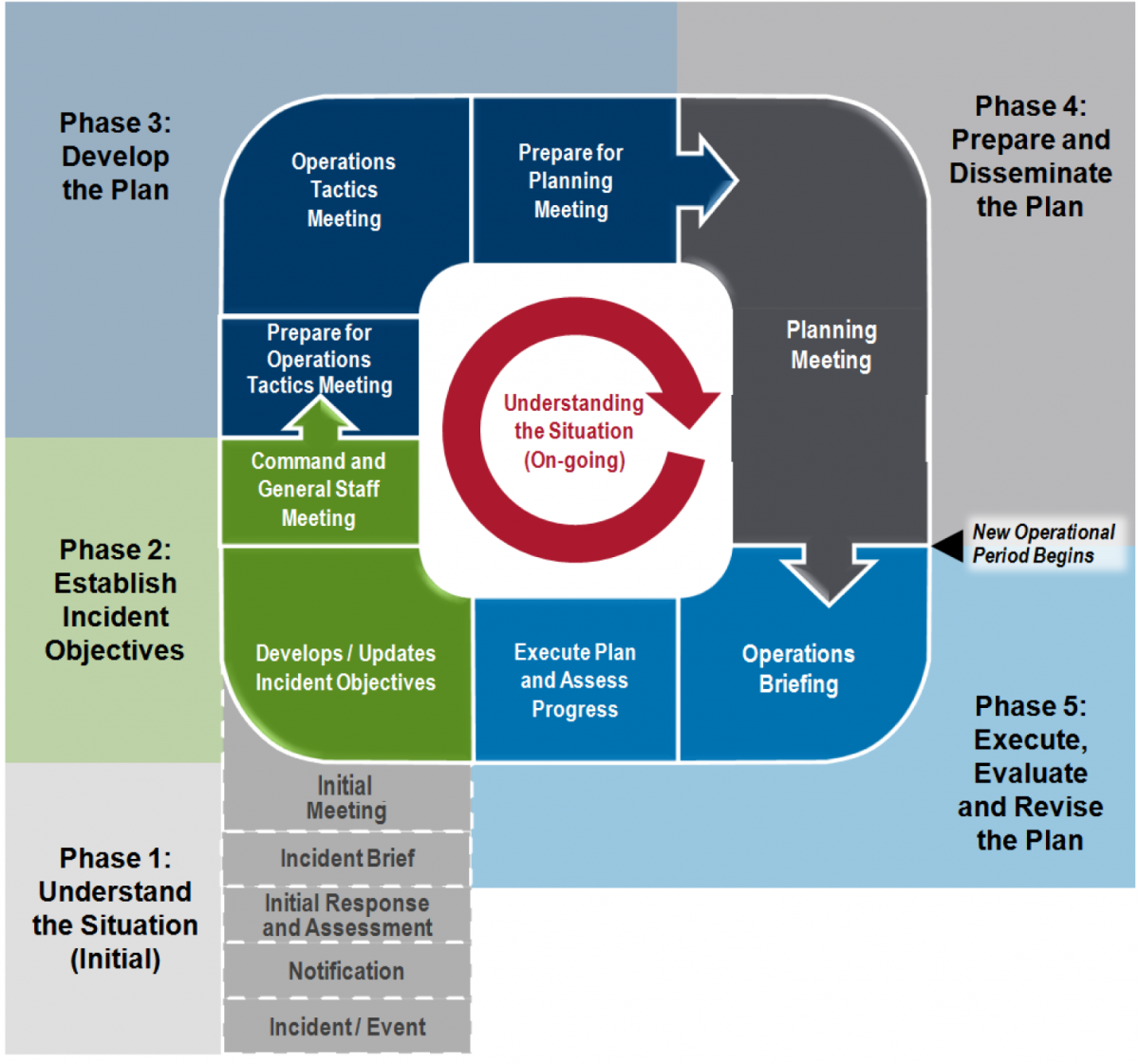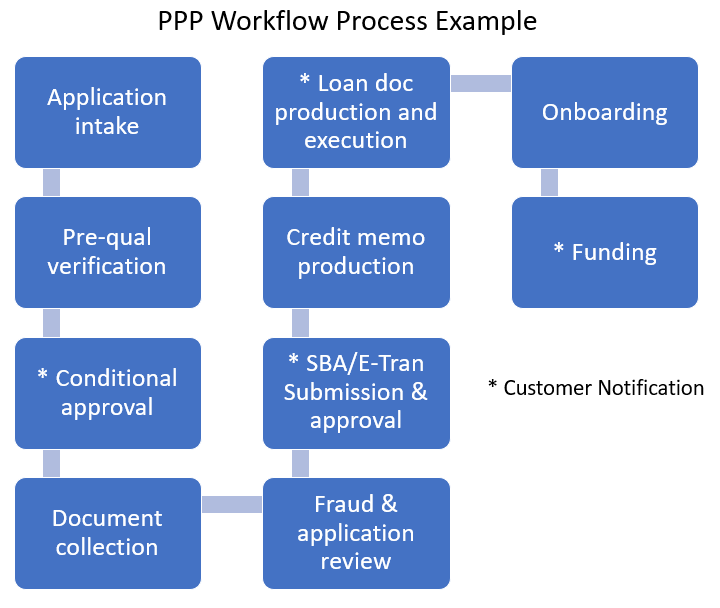Managing The PPP Event With the Power Planning P
If you are in the military or public safety and have participated in a tactical operation center, you are likely familiar with the “Planning P.” The Planning P is a national framework that helps quickly assimilate information and drive to decisions. This is exactly what is needed in any fast-moving event, such as if your bank has been involved in the production of Paycheck Protection Program (PPP) loans. It is also a great tool for any leader or manager to have, as many of these concepts are applicable to everyday business activity. We present some of the concepts and steps below.
Planning P Concepts
The basic tenet of the Planning P is the management of any fast-moving event, such as PPP, is using clear objectives for every operational period. Each operational period is a day, or in many cases, is a 12-hour period as many banks have run two shifts, 24/7 to accomplish the production of PPP loans.
Every operational period has a clear set of objectives with a known “Leader’s Intent.” While we have covered the concept of Leader’s Intent in detail HERE, the short version is not only must the objective of the period be identified but also what the intent of the period. That is to say, the end-state or what you want success to look like needs to be clearly identified.
For example, for the first operational period that started for most banks last Friday, the objective was to finalize the process, establish an organizational structure, build infrastructure and start to test the application process with a specific number of customers such as 100. Based on that objective, a leader might say – “In the next 12-hours, we would like to test market the PPP application process in all of our markets to 150 customers, so we get 100 applications in by midnight.” The emphasis here is around the building and testing the start of the processes in a very deliberate way. This is a very different set of objectives as the need to pull as may E-Tran numbers as possible to register the loan with the Small Business Administration (SBA) or try to document and fund as many loans as possible.
To accomplish a series of these operational periods and successfully manage both period objectives and intent, the following steps are helpful:
Step One: Set Your Organizational Structure
In a rapidly changing event, a million decisions must be made, and the lack of communication can quickly cause chaos. This is why an organizational structure is critical. Banks can start small, with just a couple people at the initial phase of the event, and then expand as the event unfolds. Smaller banks can utilize the same structure only on a collapsed version. You can have one team running all of logistics or finance. However, larger banks can expand the structure to match the objectives.
For PPP, some banks have found it useful to create a “problem resolution task force” that solves production problems as they occur. Other banks have added a “Cavalry” that is a quickly deployable workforce that can apply processing power to any division. They can help customers with their applications on the front end during the initial week and then move to help with document production the second week.
The goal is to have a unified leadership team composed of each responsible group while having a framework that is common to each team and from event to event. The structure allows for agile movement across the organization.

Step Two: Set Your Operational Cadence
Expectations about the process must be clearly defined and then validated often. All parties should know when they are meeting, when they are reporting or receiving reports; and, how long the operational period is to go. As the situation changes, the cadence can be sped up or slowed down.
When setting cadence, the essence of the “Power Planning P” is established as outlined below. The Planning P dictates a certain “battle rhythm,” which starts with “Phase 1,” which is gathering intelligence, assessing the effort, calling an initial meeting to brainstorm the approach, and then preparing the details for the first objective setting meeting.

Phase 2 starts with the development of the event or incident objectives, which are then brought to the event leadership for consideration. It is here that the leadership agrees on what they want to be done in broad strokes. The strategy and planning group are then responsible for developing a plan to accomplish the objectives while logistics, finance, and risk all offer support and oversee the complete process.
Once the event objectives and plans are developed, a “Tactics Meeting” is held to establish the operational period tactics that help the bank meet the operational period’s objectives. These tactics, conducted in Phase 3, are then part of an overall event planning meeting where all department’s hone the plan and prepare for a mission briefing.
After the initial phases, each day starts in Phase 5 with an event-wide operational briefing. Everyone breaks from the briefing (these days a large video call) and starts to execute the strategy and tactics. “Command Staff” in conjunction with team leads usually get together mid-afternoon and start the cycle all over again in Phase 2 as leadership sets up for the next operational period.
Step Three: Be Clear on Your Workflow
Once the entire event team understands the cycle of the Power Planning P, the next idea to socialize is to be sure everyone is clear on the workflow. While this can be done in many ways, below is an example of a popular PPP workflow. Each box below has a Team Lead that composes the “General Staff,” which is in-turn, managed by the Command, or event staff.

By dividing the team into distinct specialties, not only is production throughput enhanced, but communication and coordination become easier. This framework also has the advantage of assisting in resource management. As bottleneck occur in production such as with E-Trans or onboarding, resources can be shifted quickly. Having a working structure in place, for example, allows the team from Fraud Review to quickly move over and assimilate into Onboarding since the team and processes are already stood up.
Step Four: Conducting Your Planning Meeting
Perhaps the most critical aspect of Planning P is the Planning Meeting. This is where the “Power” in the “Power Planning P” comes in. High-performance incident teams tend to have a very clear methodology for conducting the planning meeting that synthesizes information the most efficient way possible. A well-run planning meeting starts with an overview from the event manager and then a check-in from each Team Lead using the format below:
Current Status: What are the current department metrics such as how many PPP loans are processed, how many people are on staff, what is the rate of processing and other details about the operation? The goal here is for each manager to give a brief overview of the current situation from the group’s perspective.
Future: What is the next period’s objectives, and what does the department hope to accomplish? The Team Lead quickly imparts the goal and tactics for the next period. This allows all groups to understand where each unit is going.
Required Resources: What resources are needed and what contingencies are required to achieve the tactics set forth to accomplish future objectives.
Risks: What are the current problems and risks of the operation that everyone should be made aware of so that the risk is reduced.
Once all team leads, including Logistics, Finance, and Risk, have had a chance to give their input, the Event Lead then goes back and prioritizes topics in order to work through and fine-tune the plan.
For PPP, it is this meeting where both the upstream and downstream workflow is considered when working through problems. If you adjust payroll or loan amount, how will that impact risk, documentation, the application, or other areas of the operation? Having everyone together allows the team leads to talk about each point and get clarity before they present to the entire event team at the start of the next day.
Conducting a meeting in this way provides a robust framework to gather information, agree on a set of assumptions and truths, decide on a plan, and then get on the same page about how to present that plan. Following this structure speeds with the dissemination and synthesis of the information to allow for rapid decision making.
Step Five: Review and Assess
After the entire event team is briefed, the Command Staff spends time in the field working with each Team Lead, talking to customers, hearing from customer support, and monitoring the metrics. By early afternoon each day, leaders should discuss potential process improvements that will then help the setting of period objectives and tactics. This feedback loop is critical each day in order to enhance the production of the next operational period.
The Continuous Cycle and Thinking Ahead
The top of the “P” is then repeated once per operational period and continues until the event winds down. By late morning, every leader should start thinking about the next operational period and how they are going to hand off the information and objectives in order to maintain continuity. Part of every operational period is making sure the next operational period has the needed objectives, plans, resources, and messaging.
Now, for example, many banks are thinking about how to message customers and suspend operations should the Treasury allocated money for the PPP stop. This is just one of the thousands of other examples that operating teams need to prepare for and make now to make future operational periods more effective. It is the leader’s job to think at least one operational period ahead while the troops are focused in the current period’s operation.
Putting This Into Action
This framework isn’t the only incident framework that is effective, but it is the most tested. It has served many branches of the military, the responders to 9/11, hurricanes, wildfires, and banks working around the clock to generate PPP loans. Any fast-moving event can benefit from the Power Planning P and the related concepts.
We expect not only for the PPP to be extended, but a variety of other programs be released, each of which may require its own incident team. As such, it is also critical that banks record their journey so that checklists and event plans can be created to aid in future efforts. Try these concepts and see if it makes your operational periods run smoother.

